Deck 12: Physiology
Question
Question
Question
Question
Question
Question
Question
Question
Question
Question
Question
Question
Question
Question
Question
Question
Question
Question
Question
Question
Question
Question
Question
Question
Question
Question
Question
Question
Question
Question
Question
Question
Question
Question
Question
Question
Question
Question
Question
Question
Question
Question
Question
Question
Question
Question
Question
Question
Question
Question
Question
Question
Question
Question
Question
Question
Question
Question
Question
Question
Question
Question
Question
Question
Question
Question
Question
Question
Question
Question
Question
Question
Question
Question
Question
Question
Question
Question
Question
Question

Unlock Deck
Sign up to unlock the cards in this deck!
Unlock Deck
Unlock Deck
1/339
Play
Full screen (f)
Deck 12: Physiology
1
A 35-year-old man comes to the office due to recent erectile dysfunction. He has no medical conditions and takes no medications. He states that he has a loss of libido and chronic headaches for 3 months. He does not use tobacco, alcohol, or illicit drugs. Vital signs are normal. The examination is notable for peripheral vision loss, bilateral gynecomastia, and soft testes without masses. Laboratory evaluation shows normal serum prolactin, normal B-hCG, low serum LH, and low serum testosterone. Which of the following is the most likely mechanism for this patient's gynecomastia?
A)Decreased systemic clearance of estrogen
B)Defective androgen receptor function
C)Enzymatic defect in the testosterone biosynthetic pathway
D)Excessive estrogen production in the testes
E)Persistent aromatization of adrenal estrogen precursors
A)Decreased systemic clearance of estrogen
B)Defective androgen receptor function
C)Enzymatic defect in the testosterone biosynthetic pathway
D)Excessive estrogen production in the testes
E)Persistent aromatization of adrenal estrogen precursors
Persistent aromatization of adrenal estrogen precursors
2
Scientists studying the specifics of human kidney function develop a new technique for measuring the concentration of various compounds along the length of the proximal tubule. They measure the concentrations of several endogenous substances in the fluid traversing the proximal tubule during an experiment. The following image depicts the tubular fluid/plasma ultrafiltrate concentration ratios for the measured substances: 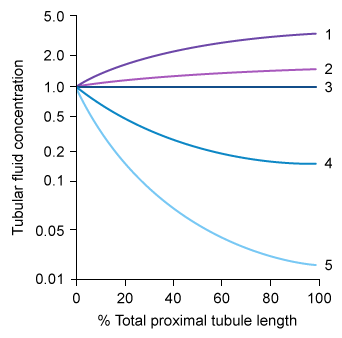 Which of the following substances are most likely to produce lines 2 and 4, respectively?
Which of the following substances are most likely to produce lines 2 and 4, respectively?
A)Bicarbonate, sodium
B)Creatinine, amino acids
C)Creatinine, glucose
D)Potassium, chloride
E)Urea, bicarbonate
 Which of the following substances are most likely to produce lines 2 and 4, respectively?
Which of the following substances are most likely to produce lines 2 and 4, respectively?A)Bicarbonate, sodium
B)Creatinine, amino acids
C)Creatinine, glucose
D)Potassium, chloride
E)Urea, bicarbonate
Urea, bicarbonate
3
A 32-year-old woman comes to the office due to a persistent weight loss.The patient has no medical problems and takes no medications or supplements. She does not use tobacco, alcohol, or illicit drugs. She states that she feels warm compared to other in the room Family history is significant for hypothyroidism in her mother. Temperature is 36.7 C (98 F), blood pressure is 130/60 mm Hg, and pulse is 104/min. BMI is 20 kg/m2. On physical examination, the patient appears anxious and has a staring gaze. There is exophthalmos, lid lag, and a diffusely enlarged thyroid with an audible thyroid bruit. The patient has a fine tremor on outstretched arms, and the skin is warm and moist. Antibodies directed against which of the following are most likely to be found in this patient?
A)Thyroglobulin
B)Thyroid peroxidase
C)Thyrotropin receptor
D)Thyroxine
E)Triiodothyronine
A)Thyroglobulin
B)Thyroid peroxidase
C)Thyrotropin receptor
D)Thyroxine
E)Triiodothyronine
Thyrotropin receptor
4
Renal physiologists are investigating how hydration status affects human urine concentration and dilution mechanisms. To accomplish this, they developed a technique in experimental animals that allows tubular fluid sampling in various parts of the nephron. After 12 hours of water deprivation, a healthy animal produces a tubular fluid sample with an osmolarity of 110 mOsm/L. If the physiology of this animal is similar to that of humans, which of the following sites along the nephron was most likely sampled? 
A)A
B)B
C)C
D)D
E)E

A)A
B)B
C)C
D)D
E)E

Unlock Deck
Unlock for access to all 339 flashcards in this deck.
Unlock Deck
k this deck
5
An 8-year-old boy is brought by his mother due to concerned to his weight. The patient weight is on 5th percentile for his age. He has no medical conditions or family history of any inheritied diseases. On examination, the patient is hyperactive with sweating hand, impulsive, inattentive, and restless. His grade has declined recently. The thyroid gland is diffusely enlarged to palpation without tenderness or bruit. Neurologic examination reveals no focal findings. Results of thyroid function tests are : elevation of TSH, T4 and Total T3. Which of the following is the most likely etiology of this patient's thyroid function test abnormalities?
A)Chronic autoimmune thyroiditis
B)Elevated thyroxine-binding globulin
C)Graves disease
D)Organification defect in thyroid hormone synthesis
E)Resistance to thyroid hormone
A)Chronic autoimmune thyroiditis
B)Elevated thyroxine-binding globulin
C)Graves disease
D)Organification defect in thyroid hormone synthesis
E)Resistance to thyroid hormone

Unlock Deck
Unlock for access to all 339 flashcards in this deck.
Unlock Deck
k this deck
6
A research hospital's nephrologists are looking into the physiologic changes that occur in diabetes insipidus. The group creates a technique that allows tubular urine sampling in experimental animals with human-like physiology. Following hypophysectomy, tubular fluid samples are collected from multiple sites throughout the nephron. Fluid from which of the following sampling sites is most likely to have the highest osmolarity in the absence of antidiuretic hormone? 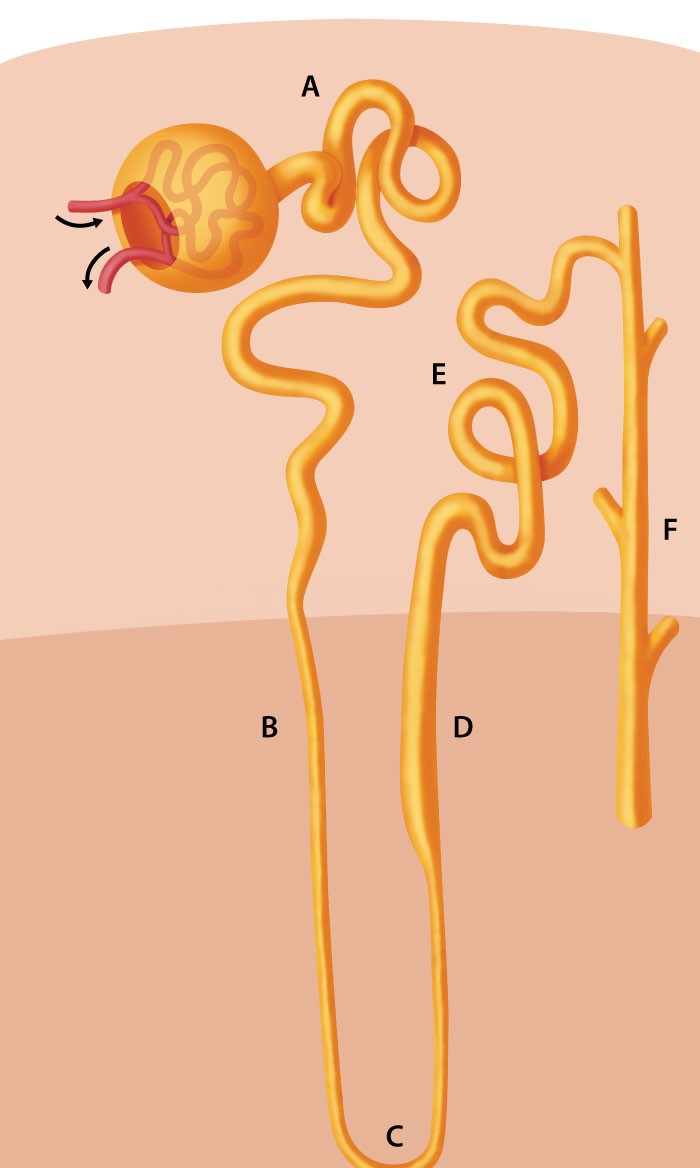
A)A
B)B
C)C
D)D
E)E
F)F

A)A
B)B
C)C
D)D
E)E
F)F

Unlock Deck
Unlock for access to all 339 flashcards in this deck.
Unlock Deck
k this deck
7
A 65-year-old women comes to the office due to acute back pain after left heavy box. The patient has also had weakness and weight loss for the past 2 months. Blood pressure is 155/705 mm Hg and pulse is 110/min. Examination shows sweaty palms and a fine hand tremor. Laboratory evaluation reveals normal hemoglobin, serum calcium, serum creatinine, and 25-hydroxyvitamin D levels. Serum thyrotropin (TSH) is undetectable. X-ray reveals a compression fracture of the T7 vertebra with diffuse demineralization of the bones. Which of the following is most likely responsible for the bone abnormalities in this patient?
A)Decreased bone formation due to inhibition of osteoblast differentiation
B)Decreased mineralization of bone matrix
C)Increased bone resorption due to increased calcitonin release
D)Increased bone resorption due to stimulation of osteoclasts
E)Interleukin-1-induced uncoupling of bone resorption and formation
A)Decreased bone formation due to inhibition of osteoblast differentiation
B)Decreased mineralization of bone matrix
C)Increased bone resorption due to increased calcitonin release
D)Increased bone resorption due to stimulation of osteoclasts
E)Interleukin-1-induced uncoupling of bone resorption and formation

Unlock Deck
Unlock for access to all 339 flashcards in this deck.
Unlock Deck
k this deck
8
A 41-year-old man comes to the office for routine follow up. He feels fatigue, headache, weight loss, sweating, and palpitations. He is otherwise healthy and takes no medications. He does not use tobacco, alcohol, or illicit drugs. Physical examination reveals lid lag and a fine hand tremor. Neck examination reveals mild, diffuse enlargement of the thyroid gland. Laboratory results are high TSH and T4, T3: Which of the following is the most likely cause of this patient's disorder?
A)Elevated thyroxine-binding globulin
B)Graves disease
C)Painless thyroiditis
D)Pituitary tumor
E)Thyroid cancer
A)Elevated thyroxine-binding globulin
B)Graves disease
C)Painless thyroiditis
D)Pituitary tumor
E)Thyroid cancer

Unlock Deck
Unlock for access to all 339 flashcards in this deck.
Unlock Deck
k this deck
9
A 42-year-old man comes to the physician because of a 1-year history of progressive fatigue and shortness of breath on exertion. He also finds it difficult to sleep lying flat and requires 3 pillows to prop himself upright when sleeping. He has smoked one pack of cigarettes daily for 30 years and drinks three to four cans of beer daily. He appears fatigued. Pulse is 94/min, respirations are 23/min, and blood pressure is 150/60 mm Hg. Blood pressure is 170/100 mm Hg, and pulse is 80/min and regular. Physical examination reveals bilateral basilar lung crackles, jugular venous distension, and bilateral lower extremity edema. Chest x-ray reveals cardiomegaly and hilar prominence. ECG shows left ventricular hypertrophy. Echocardiogram shows elevated pressures in the pulmonary artery. Which of the following is the most likely underlying cause of the observed echocardiographic finding in this patient?
A)Hypoxia-induced pulmonary vasoconstriction
B)Increased pulmonary arterial blood flow
C)Increased pulmonary venous pressure
D)Inflammatory pulmonary vascular disease
E)Obliteration of the pulmonary vascular bed
F)Thrombotic obstruction of the pulmonary arterial tree
A)Hypoxia-induced pulmonary vasoconstriction
B)Increased pulmonary arterial blood flow
C)Increased pulmonary venous pressure
D)Inflammatory pulmonary vascular disease
E)Obliteration of the pulmonary vascular bed
F)Thrombotic obstruction of the pulmonary arterial tree

Unlock Deck
Unlock for access to all 339 flashcards in this deck.
Unlock Deck
k this deck
10
Physiologists are investigating how the plasma concentration of various substances affects their excretion in the urine. In one experiment, a freely filtered substance at the glomerulus is infused intravenously at various rates. The substance's plasma concentration (mg/mL) and urinary excretion rate (mg/min) are measured. The following observations are made assuming a constant glomerular filtration rate (GFR) of 100 mL/min:  Which of the following substances is most likely to demonstrate a similar pattern of filtration and excretion in a healthy adult?
Which of the following substances is most likely to demonstrate a similar pattern of filtration and excretion in a healthy adult?
A)Albumin
B)Creatinine
C)Glucose
D)Mannitol
E)Urea
 Which of the following substances is most likely to demonstrate a similar pattern of filtration and excretion in a healthy adult?
Which of the following substances is most likely to demonstrate a similar pattern of filtration and excretion in a healthy adult?A)Albumin
B)Creatinine
C)Glucose
D)Mannitol
E)Urea

Unlock Deck
Unlock for access to all 339 flashcards in this deck.
Unlock Deck
k this deck
11
A physiologist is conducting an experiment to study potassium channels mutation expressed in pancreatic beta cells. The mutated channels have a higher sensitivity to the substance that normally modulates their activity, causing increased beta cell secretory activity. Which of the following substances normally binds to and regulates the ion channels that are responsible for this patient's hypoglycemia?
A)ATP
B)Citrate
C)Fructose-6-phosphate
D)Fumarate
E)Glucose
F)Lactate
G)Malate
H)Pyruvate
A)ATP
B)Citrate
C)Fructose-6-phosphate
D)Fumarate
E)Glucose
F)Lactate
G)Malate
H)Pyruvate

Unlock Deck
Unlock for access to all 339 flashcards in this deck.
Unlock Deck
k this deck
12
A 32-year-old woman comes to the physician because of progressive fatigue and shortness of breath on exertion. She has smoked one pack of cigarettes daily for 20 years. The patient's mother died of pulmonary arterial hypertension at age 42. Vital signs are within normal limits. Physical examination shows jugular venous pulsations 9 cm above the sternal angle. The lungs are clear to auscultation. There is a normal S1 and a loud, split S2. An impulse can be felt with the fingers left of the sternum. The abdomen is soft and nontender to palpation. ECG shows right axis deviation. If this patient's condition is inherited, which of the following is the most likely direct cause of her disease?
A)Elevated left atrial pressure
B)Hypoxic vasoconstriction
C)Right ventricular hypertrophy
D)Thrombotic occlusion of pulmonary arteries
E)Vascular smooth muscle proliferation
A)Elevated left atrial pressure
B)Hypoxic vasoconstriction
C)Right ventricular hypertrophy
D)Thrombotic occlusion of pulmonary arteries
E)Vascular smooth muscle proliferation

Unlock Deck
Unlock for access to all 339 flashcards in this deck.
Unlock Deck
k this deck
13
A 48-year-old woman is evaluated for vaginal discharge and postcoital bleeding. A friable mass at the cervix that bleeds easily on touch is discovered during a pelvic examination. A cervical biopsy reveals invasive squamous cell cancer of the cervix and uterus. There are no lymph node metastases. During a radical hysterectomy, the right ureter is accidentally injured but then repaired. Following surgery, imaging studies reveal a partial obstruction of the right ureter with mild dilation of the proximal collecting system. Which of the following changes in the right kidney is most likely? 
A)A
B)B
C)C
D)D
E)E

A)A
B)B
C)C
D)D
E)E

Unlock Deck
Unlock for access to all 339 flashcards in this deck.
Unlock Deck
k this deck
14
A physiologist is conducting an experiment to study potassium channels mutation expressed in pancreatic beta cells. The mutated channels have a higher sensitivity to the substance that normally modulates their activity, causing increased beta cell secretory activity. Which of the following substances normally binds to and regulates the ion channels that are responsible for this patient's hypoglycemia?
A)ATP
B)Citrate
C)Fructose-6-phosphate
D)Fumarate
E)Glucose
F)Lactate
G)Malate
H)Pyruvate
A)ATP
B)Citrate
C)Fructose-6-phosphate
D)Fumarate
E)Glucose
F)Lactate
G)Malate
H)Pyruvate

Unlock Deck
Unlock for access to all 339 flashcards in this deck.
Unlock Deck
k this deck
15
A 23-year-old man arrives at the emergency department after experiencing abdominal pain and nausea for several hours. He also claims to have vomited and to have noticed that his urine has a fruity odor. For several days, the patient has had increased thirst and urination, as well as weight loss. He has no known medical issues and does not take any medications. Pallor with cool extremities is revealed on physical examination. The abdomen is soft and not tender to palpation. To confirm the diagnosis, laboratory tests are ordered. Which of the following graph points best represents this patient's acid-base status? 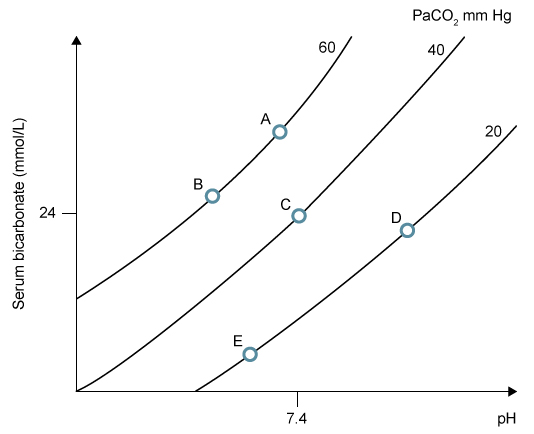
A)Point A
B)Point B
C)Point C
D)Point D
E)Point E

A)Point A
B)Point B
C)Point C
D)Point D
E)Point E

Unlock Deck
Unlock for access to all 339 flashcards in this deck.
Unlock Deck
k this deck
16
A 16-year-old man comes to the office due to frequent episodes of disorientation, palpitations, tremulousness, and excessive sweating over the past 3 months. He says the symptoms resolve quickly after drinking some juice or a carbonated beverage. The patient was diagnosed with type 1 diabetes mellitus at age 12 and takes short- and long-acting insulin. He has had no dose changes in the past 2 years or diabetic complications and follows up with an ophthalmologist frequently. The patient is a college student and reports some stress due to an upcoming midterm examination. He does not use tobacco, alcohol, or illicit drugs. Vital signs and physical examination are within normal limits. Laboratory results show a hemoglobin A1c of 6.8% and no proteinuria. Which of the following factors most likely precipitated this patient's current symptoms?
A)Fructose-rich drink consumption
B)Intense exercise
C)Mental stress
D)Respiratory infection
E)Sleep deprivation
F)Weight gain
A)Fructose-rich drink consumption
B)Intense exercise
C)Mental stress
D)Respiratory infection
E)Sleep deprivation
F)Weight gain

Unlock Deck
Unlock for access to all 339 flashcards in this deck.
Unlock Deck
k this deck
17
A 38-year-old woman comes to the physician because of a 4-month history of worsening fatigue. She has had occasional exertional chest pain and shortness of breath over the past year but has not seen a physician. She takes no medications. Her temperature is 37°C (98.6°F), pulse is 94/min, respirations are 24/min, and blood pressure is 130/84 mm Hg. Physical examination reveals a loud pulmonic component of S2 but is otherwise unremarkable. Chest x-ray is normal. Echocardiography shows elevated pulmonary artery systolic pressure and right ventricular hypertrophy. Left ventricular structure and function are normal. Which of the following patterns of chemical mediators is most likely present in this patient's pulmonary arteries? 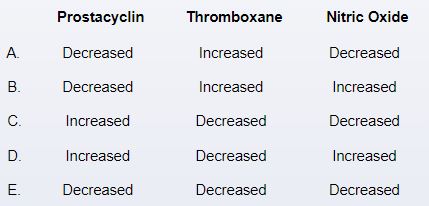


Unlock Deck
Unlock for access to all 339 flashcards in this deck.
Unlock Deck
k this deck
18
A 33-year-old diabetic man comes to the clinic for follow up. The patient has been diagnosed with type I diabetes since age 10 and he takes insulin to controls blood suger. Recently, he has had more frequent episodes of hypoglycemia despite no changes in his treatment, diet, or physical activity, but the episodes have been associated with less severe hypoglycemic symptoms compared to prior episodes. Physical examination is unremarkable. Laboratory results show normal basic metabolic panel and serum TSH level. Hemoglobin A1c is 7.0%. Which of the following factors is primarily responsible for this patient's increased frequency of hypoglycemia?
A)Decreased epinephrine release
B)Decreased glucagon release
C)Decreased growth hormone release
D)Downregulation of insulin receptors
E)Upregulation of beta-adrenergic receptors
A)Decreased epinephrine release
B)Decreased glucagon release
C)Decreased growth hormone release
D)Downregulation of insulin receptors
E)Upregulation of beta-adrenergic receptors

Unlock Deck
Unlock for access to all 339 flashcards in this deck.
Unlock Deck
k this deck
19
A 56-year-old man with polycystic kidney disease and chronic renal insufficiency is evaluated for the placement of an arteriovenous fistula for dialysis access. The blood pressure is 140/90 mm Hg, and the pulse rate is 80 beats per minute. The lower extremities have 2+ bilateral edema, according to the examination. The glomerular filtration rate is estimated to be 15 mL/min/1.73 m2. Which of the following lab results is most likely in this patient?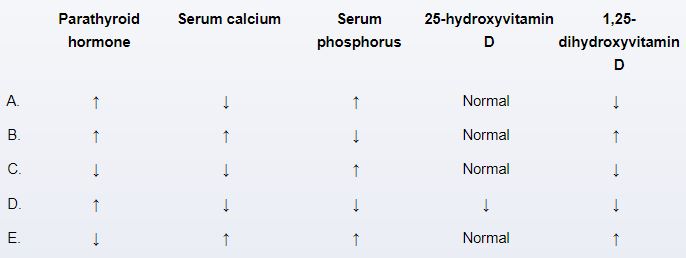
A)A
B)B
C)C
D)D
E)E

A)A
B)B
C)C
D)D
E)E

Unlock Deck
Unlock for access to all 339 flashcards in this deck.
Unlock Deck
k this deck
20
A 32-year-old woman comes to the office due to recent fatigue and weight gain. She has no medical histrory and takes no medication. Blood pressure is 115/65 mm Hg and pulse is 85/min. On physical examination, there is a diffuse neck swelling with no palpable nodules, she says her neck has gradually gotten larger, and she does not like how it appears in the mirror. Serum TSH and free thyroxine levels are normal. She has a sister with vitiligo. There is no history of head and neck irradiation. Antibodies against thyroid peroxidase are present in high titers. The antigenic target of these antibodies is involved in which of the following processes?
A)Iodide uptake
B)Iodotyrosine deiodination
C)Thyroglobulin iodination
D)Thyroglobulin synthesis
E)Thyroxine to triiodothyronine conversion
A)Iodide uptake
B)Iodotyrosine deiodination
C)Thyroglobulin iodination
D)Thyroglobulin synthesis
E)Thyroxine to triiodothyronine conversion

Unlock Deck
Unlock for access to all 339 flashcards in this deck.
Unlock Deck
k this deck
21
A 43-year-old woman is being evaluated in the surgery department because of severe central chest pain, mild shortness of breath, and one episode of coughing up blood. Two days ago, she underwent a total hip arthroplasty with no operative complications. CT pulmonary angiogram shows a right lower lobe pulmonary artery occlusion consistent with pulmonary embolism but no evidence of pulmonary infarction. Which of the following is the most likely reason for the lack of lung tissue necrosis in this patient?
A)Collateral circulation
B)Decreased surfactant
C)Endothelial tissue plasminogen activator
D)Increased pulmonary venous pressure
E)Intrapulmonary shunting
A)Collateral circulation
B)Decreased surfactant
C)Endothelial tissue plasminogen activator
D)Increased pulmonary venous pressure
E)Intrapulmonary shunting

Unlock Deck
Unlock for access to all 339 flashcards in this deck.
Unlock Deck
k this deck
22
A 67-year-old woman is admitted to the hospital due to worsening abdominal pain. The patient has long-term end-stage renal disease caused by diabetic nephropathy, for which she receives hemodialysis three times per week. The temperature is 37 degrees Celsius (98.6 degrees F), the blood pressure is 159/79 mm Hg, the pulse rate is 97 bpm, and the respirations rate is 16 /minute. High-pitched bowel sounds and mild distension without rebound tenderness are seen on abdominal examination. Blood urea nitrogen and creatinine levels are elevated, according to laboratory results. A small bowel obstruction is visible on a noncontrast CT scan of the abdomen. The arrows in the abdominal CT scan below show the following findings in the patient: 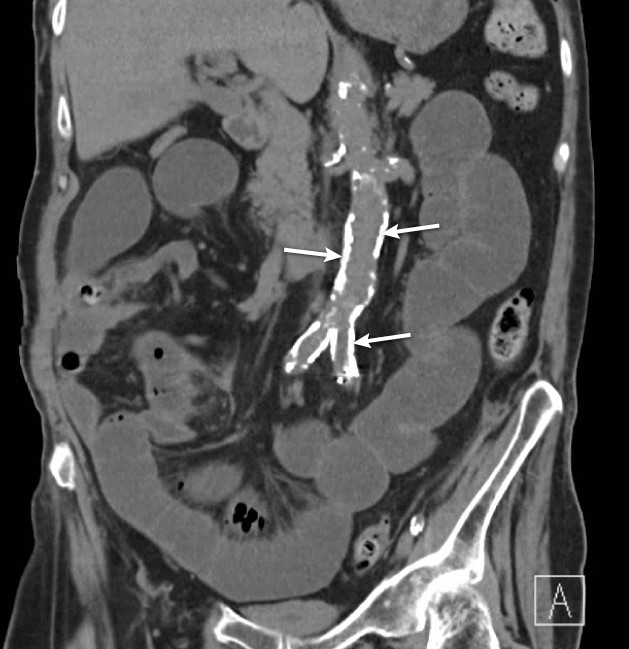 Which of the following most likely contributed to the observed findings?
Which of the following most likely contributed to the observed findings?
A)Hypermagnesemia
B)Hyperphosphatemia
C)Hypocalcemia
D)Hypophosphatemia
E)Recurrent hypoglycemia
 Which of the following most likely contributed to the observed findings?
Which of the following most likely contributed to the observed findings?A)Hypermagnesemia
B)Hyperphosphatemia
C)Hypocalcemia
D)Hypophosphatemia
E)Recurrent hypoglycemia

Unlock Deck
Unlock for access to all 339 flashcards in this deck.
Unlock Deck
k this deck
23
A 42-year-old male is brought to the ER due to found to be unresponsive. He has a history of alcohol disorder. In ER he looks disoriented, malnourished, and confused. Thiamine, Folic acid, and dextrose-containing IV fluid are given. After a few hours. He develops marked muscle weakness. On lab tests there is an obvious low serum phosphate concentration of 0.4 mg/dl (normal: 2.5-4.5). Which of the following is the most likely cause of this patient's low serum phosphate level?
A)Decreased renal proximal tubular reabsorption
B)Increased colonic excretion of phosphate
C)Increased extracellular binding with calcium
D)Increased uptake by bone cells
E)Redistribution of phosphate into hepatic and muscle cells
A)Decreased renal proximal tubular reabsorption
B)Increased colonic excretion of phosphate
C)Increased extracellular binding with calcium
D)Increased uptake by bone cells
E)Redistribution of phosphate into hepatic and muscle cells

Unlock Deck
Unlock for access to all 339 flashcards in this deck.
Unlock Deck
k this deck
24
A 65-year-old man with type 2 diabetes mellitus visits the doctor for a routine check-up. He began taking oral hypoglycemic medications 12 years ago but was recently switched to long-acting insulin due to poor blood sugar control. His most recent serum creatinine level was 2.1 mg/dL. The patient is concerned about his elevated creatinine level and how it relates to his kidney function. Which of the following graphs most accurately represents the relationship between serum creatinine and glomerular filtration rate?
A)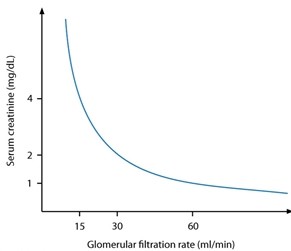
B)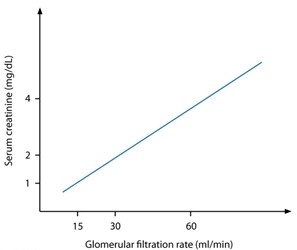
C)
D)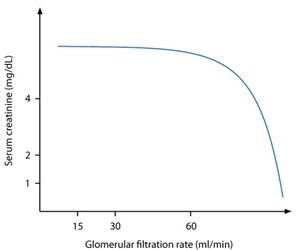
A)

B)

C)

D)


Unlock Deck
Unlock for access to all 339 flashcards in this deck.
Unlock Deck
k this deck
25
A 16-year-old boy is brought to the ER by his mother due to sudden onset of heart palpitations. He has no prior medical conditions or family history of any disease. Blood pressure is 115/75 mm Hg and pulse is 160/min and regular. The physician applied a gentle neck massage just below the angle of the right mandible and his condition is immediatly improved. His blood pressure is now 120/80 mm Hg and pulse is 70/min. Which of the following mechanisms is responsible for improvement of this patient's condition?
A)Decreased baroreceptor firing rate
B)Increased sympathetic output to the sinoatrial node
C)Increased systemic vascular resistance
D)Prolonged atrioventricular node refractory period
E)Prolonged ventricular myocardium refractory period
A)Decreased baroreceptor firing rate
B)Increased sympathetic output to the sinoatrial node
C)Increased systemic vascular resistance
D)Prolonged atrioventricular node refractory period
E)Prolonged ventricular myocardium refractory period

Unlock Deck
Unlock for access to all 339 flashcards in this deck.
Unlock Deck
k this deck
26
A 34-year-old man comes to the physician because of frequent headaches and blurry vision during the past 4 months. He has also had difficulties achieving an erection over the past few weeks. Medical history is unremarkable, and he takes no medications. He does not use tobacco, alcohol, or illicit drugs. Physical examination shows a temporal visual field deficit bilaterally. An MRI of the brain shows an intrasellar mass. Which of the following changes in serum GnRH, LH, and testosterone are most likely to be found in this patient? 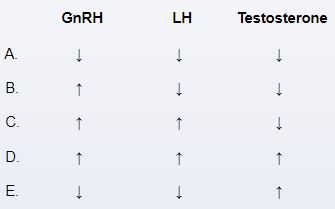


Unlock Deck
Unlock for access to all 339 flashcards in this deck.
Unlock Deck
k this deck
27
A 24-year-old healthy college student enrolls in a study to investigate the factors that influence blood oxygen content. The experiment is carried out at sea level, on room air with no additional oxygen. A method is developed to accurately measure the partial pressure of oxygen in the blood as it flows through the circulation. Blood is drawn from the vena cavae, alveolar capillaries, and aorta. All data are plotted, and the resulting curve is depicted in the graph below.  Which of the following factors most likely explains the change in partial pressure indicated by the arrow?
Which of the following factors most likely explains the change in partial pressure indicated by the arrow?
A)Diffusion-limited oxygenation
B)Increased dead space ventilation
C)Mixture with deoxygenated blood
D)Perfusion-limited oxygenation
E)Shift in the hemoglobin dissociation curve
 Which of the following factors most likely explains the change in partial pressure indicated by the arrow?
Which of the following factors most likely explains the change in partial pressure indicated by the arrow?A)Diffusion-limited oxygenation
B)Increased dead space ventilation
C)Mixture with deoxygenated blood
D)Perfusion-limited oxygenation
E)Shift in the hemoglobin dissociation curve

Unlock Deck
Unlock for access to all 339 flashcards in this deck.
Unlock Deck
k this deck
28
A physiologist is conducting an experiment to study the effect of hypertension on blood vessels and blood flow. In one of the patients , he discoves that the right renal artery is narrowed and the left renal is intact. If he concludes the flow in the vessel is decreased by factor of 16 compared to the left. By what percentage has the radius of the lumen been reduced?
A)25%
B)33%
C)50%
D)75%
E)90%
A)25%
B)33%
C)50%
D)75%
E)90%

Unlock Deck
Unlock for access to all 339 flashcards in this deck.
Unlock Deck
k this deck
29
A 43-year-old woman is brought to the emergency department because of severe central chest pain, mild shortness of breath, and one episode of coughing up blood since waking up that morning. The pain worsens on inspiration, and she describes it as 8 out of 10 in intensity. Three months ago, she underwent a left modified radical mastectomy for invasive ductal carcinoma. Her temperature is 37.8°C (100.0 °F), pulse is 103/min, respirations are 20/min, and blood pressure is 102/74 mm Hg. Arterial blood gas drawn on room air shows an arterial partial pressure of oxygen (PaO2) of 54 mm Hg and an arterial partial pressure of carbon dioxide (PaCO2) of 26 mm Hg. Which of the following processes is most likely occurring in this patient?
A)Alveolar hyperventilation
B)Decreased chest wall compliance
C)Expiratory air trapping
D)Poor respiratory drive
E)Respiratory muscle fatigue
A)Alveolar hyperventilation
B)Decreased chest wall compliance
C)Expiratory air trapping
D)Poor respiratory drive
E)Respiratory muscle fatigue

Unlock Deck
Unlock for access to all 339 flashcards in this deck.
Unlock Deck
k this deck
30
Respiratory physiologists conduct a study on healthy volunteers to assess the airway resistance of the lower respiratory tract. They measure total cross-sectional airflow resistance as it changes between airway generations during the experiment. Which of the following graphs is most likely to be observed in this study?
A)
B)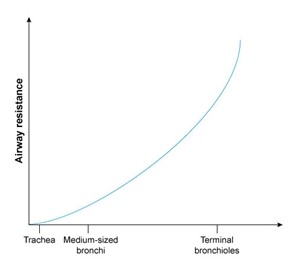
C)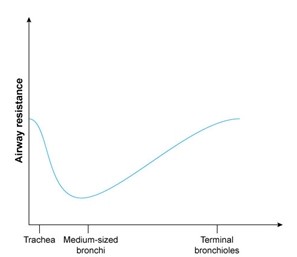
D)
E)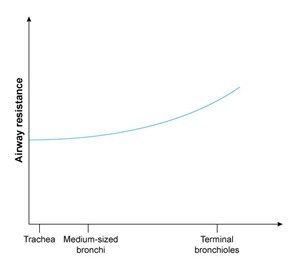
A)

B)

C)

D)

E)


Unlock Deck
Unlock for access to all 339 flashcards in this deck.
Unlock Deck
k this deck
31
A physiologist is conducting an experiment to study the effect of hypertension on blood vessels and blood flow. In one of the patients , he discoves that the right renal artery is narrowed and the left renal is intact. If he concludes the flow in the vessel is decreased by factor of 16 compared to the left. By what percentage has the radius of the lumen been reduced?
A)25%
B)33%
C)50%
D)75%
E)90%
A)25%
B)33%
C)50%
D)75%
E)90%

Unlock Deck
Unlock for access to all 339 flashcards in this deck.
Unlock Deck
k this deck
32
After being discovered unresponsive in her apartment, a 20-year-old woman is brought to the emergency department by her boyfriend. She has a history of major depression as well as generalized anxiety disorder. There is no indication of trauma. The patient is obtunded on examination and responds only to painful stimuli. There is no evidence of recent vomiting. Auscultation reveals that the lungs are clear. A toxicology screen revealed that benzodiazepines were present. Which of the following sets of arterial blood gas findings (in mm Hg) are most likely present in this patient? 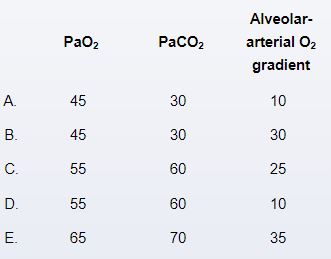
A)A
B)B
C)C
D)D
E)E

A)A
B)B
C)C
D)D
E)E

Unlock Deck
Unlock for access to all 339 flashcards in this deck.
Unlock Deck
k this deck
33
A52-year-old man is brought to the emergency department due to sudden left chest pain accompined with nausea and vomiting. the pain started 20 minutes ago during outside working. He has a history of hypertension and dyslipidemia. He has no family histroy of heart diseases. An ECG reveales normal finding and cardiac markers are normal. The physician scheduled an exercise stress test. If this patient underwent to this test, which of the following parameters is likely to be the most similar between the systemic and pulmonary circulation?
A)Arterial oxygen content
B)Arterial resistance
C)Blood flow per minute
D)Diastolic arterial pressure
E)Driving pressure for blood flow
F)Mean arterial pressure
A)Arterial oxygen content
B)Arterial resistance
C)Blood flow per minute
D)Diastolic arterial pressure
E)Driving pressure for blood flow
F)Mean arterial pressure

Unlock Deck
Unlock for access to all 339 flashcards in this deck.
Unlock Deck
k this deck
34
A 44-year-old man arrives at the emergency department complaining of sudden shortness of breath that began a few hours ago. He suffered a crush injury last week when a motorcycle ran over his left foot, and he has been immobilized due to pain since then. The patient consumes alcohol on occasion but does not use tobacco or illegal drugs. The temperature is 36.1 degrees Celsius (97 degrees Fahrenheit), the blood pressure is 118/76 mm Hg, the pulse is 102/min, and the respirations are 28 per minute. The BMI is 37 kg/m22. Physical examination reveals that the heart rhythm is regular, with normal S1 and S2 waves. Auscultation of the lungs reveals that they are clear on both sides. When compared to last week, the dorsum of his left foot has resolving ecchymoses and swelling. he right calf is swollen and tender. Which of the following arterial blood gas values are most likely to be present in this patient? 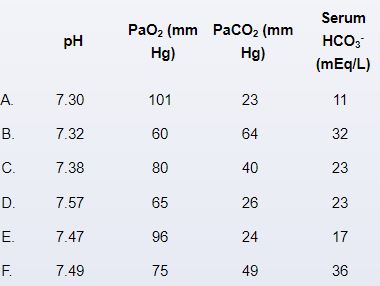
A)A
B)B
C)C
D)D
E)E
F)F

A)A
B)B
C)C
D)D
E)E
F)F

Unlock Deck
Unlock for access to all 339 flashcards in this deck.
Unlock Deck
k this deck
35
During evaluation of an old man in the outpatient clinic, he states that he has headache which responds to the over-counter medications. He has no medical conditions and takes no medications. Physical examination is normal but his blood pressure is 175/71 mmHg and pulse is 80/ min. CT scan of the head reveals no significant abnormalities. Which of the following age-related changes best explains this patient's blood pressure readings?
A)Decreased diameter of the aortic lumen
B)Decreased stroke volume
C)Increased arterial collagen deposition
D)Increased renal arterial resistance
E)Increased sympathetic tone
A)Decreased diameter of the aortic lumen
B)Decreased stroke volume
C)Increased arterial collagen deposition
D)Increased renal arterial resistance
E)Increased sympathetic tone

Unlock Deck
Unlock for access to all 339 flashcards in this deck.
Unlock Deck
k this deck
36
Physiologists are researching the normal mechanisms of pleural fluid formation and absorption. They obtain healthy experimental animals with human-like pleuropulmonary anatomy and physiology. These animals are given intravenous radioisotope tracers and closely monitored to track fluid movement into and out of the pleural space. Which of the following pathways of pleural fluid turnover is most likely to be observed? 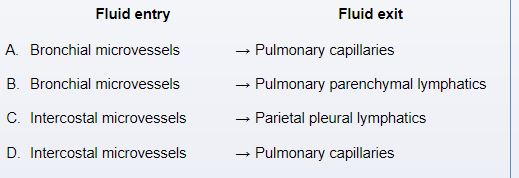
A)A
B)B
C)C
D)D

A)A
B)B
C)C
D)D

Unlock Deck
Unlock for access to all 339 flashcards in this deck.
Unlock Deck
k this deck
37
A 60-year-old man is brought to the emergency department due to progressive dyspnea and cough. He has an upper respiratory tract infection 5 days ago and has a histroy of heart failure. On physical examination, jugular venous pressure is elevated, breath sounds are decreased at the right lung base with dullness to percussion, and 2+ bilateral lower extremity pitting edema is present. Chest x-ray shows cephalization of the blood vessels, Kerley B lines, and a right pleural effusion. Thoracentesis is performed for pleural fluid analysis. In comparison to plasma fluid, which of the following pleural fluid findings is most likely to be observed?
A)High amylase content
B)High protein content
C)High white blood cell count
D)Low glucose content
E)Low lactate dehydrogenase content
A)High amylase content
B)High protein content
C)High white blood cell count
D)Low glucose content
E)Low lactate dehydrogenase content

Unlock Deck
Unlock for access to all 339 flashcards in this deck.
Unlock Deck
k this deck
38
A professional athlete, 28, takes part in a sports physiology study. She runs at a gradually increasing speed on a treadmill. Her pulse is 90 percent of her maximum heart rate based on her age after 15 minutes, and several physiologic parameters are measured. Which of the following changes have most likely occurred compared to at rest? 
A)A
B)B
C)C
D)D
E)E

A)A
B)B
C)C
D)D
E)E

Unlock Deck
Unlock for access to all 339 flashcards in this deck.
Unlock Deck
k this deck
39
A 60-year-old man is brought to the emergency department due to progressive dyspnea and cough. He has an upper respiratory tract infection 5 days ago and has a histroy of heart failure. On physical examination, jugular venous pressure is elevated, breath sounds are decreased at the right lung base with dullness to percussion, and 2+ bilateral lower extremity pitting edema is present. Chest x-ray shows cephalization of the blood vessels, Kerley B lines, and a right pleural effusion. Thoracentesis is performed for pleural fluid analysis. In comparison to plasma fluid, which of the following pleural fluid findings is most likely to be observed?
A)High amylase content
B)High protein content
C)High white blood cell count
D)Low glucose content
E)Low lactate dehydrogenase content
A)High amylase content
B)High protein content
C)High white blood cell count
D)Low glucose content
E)Low lactate dehydrogenase content

Unlock Deck
Unlock for access to all 339 flashcards in this deck.
Unlock Deck
k this deck
40
A 66-year-old woman comes to the physician for a routine health maintenance examination. She feels well but is unhappy about being overweight. She has tried to lose weight for several years without success. She goes for a walk 3 times a week but she has difficulty following a low-calorie diet. She has type 2 diabetes mellitus and osteoarthritis. Her only current medication is metformin. She has never smoked. She is 160 cm (5 ft 3 in) tall and weighs 100 kg (220 lb); BMI is 39 kg/m2. Vital signs are within normal limits. Hyperpigmentation in skinfolds is noted at the neck as shown in the image below.  Serum studies show an HbA1c of 9.5%, and a fasting serum glucose concentration of 158 mg/dL. Elevated serum levels of which of the following substances are most likely contributing to this patient's disease process?
Serum studies show an HbA1c of 9.5%, and a fasting serum glucose concentration of 158 mg/dL. Elevated serum levels of which of the following substances are most likely contributing to this patient's disease process?
A)Beta-hydroxybutyrate
B)C-peptide
C)Free fatty acids
D)High-density lipoprotein
E)Low-density lipoprotein
 Serum studies show an HbA1c of 9.5%, and a fasting serum glucose concentration of 158 mg/dL. Elevated serum levels of which of the following substances are most likely contributing to this patient's disease process?
Serum studies show an HbA1c of 9.5%, and a fasting serum glucose concentration of 158 mg/dL. Elevated serum levels of which of the following substances are most likely contributing to this patient's disease process?A)Beta-hydroxybutyrate
B)C-peptide
C)Free fatty acids
D)High-density lipoprotein
E)Low-density lipoprotein

Unlock Deck
Unlock for access to all 339 flashcards in this deck.
Unlock Deck
k this deck
41
A 43-year-old patient with dyspnea visits the doctor. The pressure/volume relationship in healthy lung tissue is represented by the black curve in the image below. The patient's lung tissue's pressure/volume connection is shown by the blue curve. 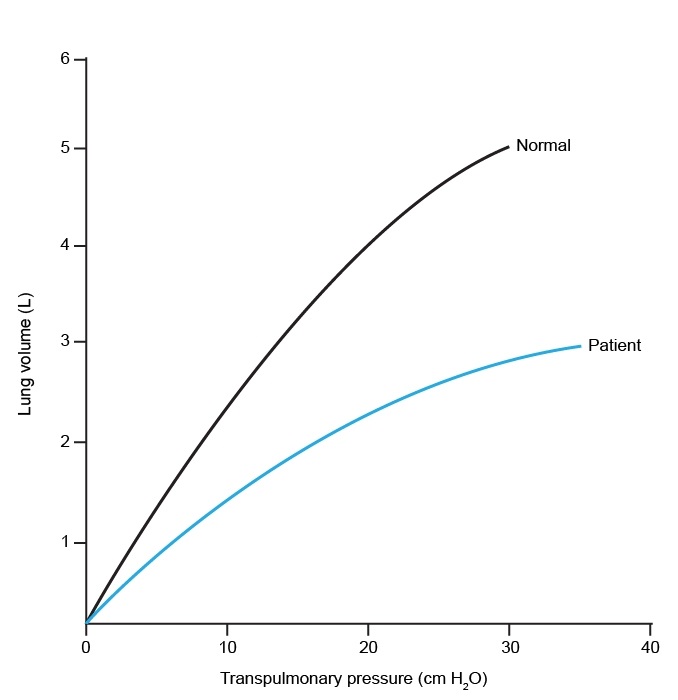 Which of the following is the most likely cause of this patient's symptoms?
Which of the following is the most likely cause of this patient's symptoms?
A)Alpha-1 antitrypsin deficiency
B)Bronchial asthma
C)Fibromyalgia
D)Idiopathic pulmonary arterial hypertension
E)Pulmonary fibrosis
 Which of the following is the most likely cause of this patient's symptoms?
Which of the following is the most likely cause of this patient's symptoms?A)Alpha-1 antitrypsin deficiency
B)Bronchial asthma
C)Fibromyalgia
D)Idiopathic pulmonary arterial hypertension
E)Pulmonary fibrosis

Unlock Deck
Unlock for access to all 339 flashcards in this deck.
Unlock Deck
k this deck
42
A physiologist is trying to study the changes in teh blood pressure during exercise. He is conducting his study on healthy participants. During the study he asks to participants to run on a treadmill at incrementally increasing speed until their heart rate reaches 90% of their expected maximum heart rate. Compared to at rest, which of the following changes in blood pressure are expected during this time? 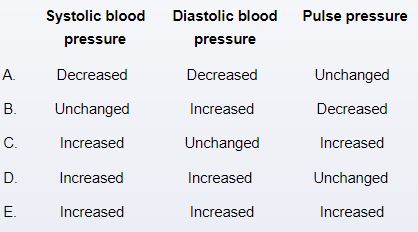
A)A
B)B
C)C
D)D
E)E

A)A
B)B
C)C
D)D
E)E

Unlock Deck
Unlock for access to all 339 flashcards in this deck.
Unlock Deck
k this deck
43
A 30-year-old lady who often lives in Florida (height near sea level) is planning a week-long business trip to La Paz, Bolivia (elevation 3,600 m [11,900 ft]). Unremarkable medical history. Which physiologic alteration is anticipated throughout the patient's week in La Paz? ![<strong>A 30-year-old lady who often lives in Florida (height near sea level) is planning a week-long business trip to La Paz, Bolivia (elevation 3,600 m [11,900 ft]). Unremarkable medical history. Which physiologic alteration is anticipated throughout the patient's week in La Paz? </strong> A)A B)B C)C D)D E)E](https://d2lvgg3v3hfg70.cloudfront.net/MD0001/11ec160b_3cde_36b9_9249_07b4ad71ea3e_MD0001_00.jpg)
A)A
B)B
C)C
D)D
E)E
![<strong>A 30-year-old lady who often lives in Florida (height near sea level) is planning a week-long business trip to La Paz, Bolivia (elevation 3,600 m [11,900 ft]). Unremarkable medical history. Which physiologic alteration is anticipated throughout the patient's week in La Paz? </strong> A)A B)B C)C D)D E)E](https://d2lvgg3v3hfg70.cloudfront.net/MD0001/11ec160b_3cde_36b9_9249_07b4ad71ea3e_MD0001_00.jpg)
A)A
B)B
C)C
D)D
E)E

Unlock Deck
Unlock for access to all 339 flashcards in this deck.
Unlock Deck
k this deck
44
A retired Athlete man is being evaluated for annual medical evaluation. He had played soccer for 10 years. He has no prior medical diseases and takes no medications. He still continues to practice aerobic exercise regularly. The patient does not use tobacco, alcohol, or illicit drugs. Blood pressure is 110/60 mm Hg and pulse is 63/min. Physical examination shows no abnormalities. Compared to a person of similar age and sex with sedentary lifestyle, which of the following cardiac changes are most likely present in this patient? 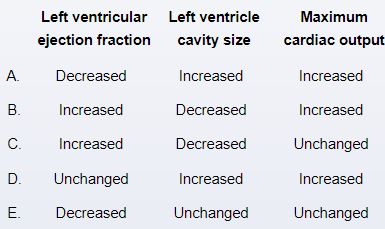
A)A
B)B
C)C
D)D
E)E

A)A
B)B
C)C
D)D
E)E

Unlock Deck
Unlock for access to all 339 flashcards in this deck.
Unlock Deck
k this deck
45
A 34-year-old man goes to Peru to take part in an adventure to climb a mountain. He doesn't take any medications and has never had a medical issue. The patient does not consume alcohol, tobacco, or illegal substances. He spends his journey in a mountainous high-altitude camp that is more than 4,000 meters (13,000 feet) above sea level. The patient is given bloodwork by the camp doctor after two days there while inhaling ambient air. Which set of arterial blood gas readings from the list below is most likely to be observed in this patient? 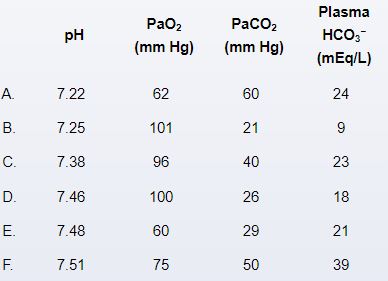
A)A
B)B
C)C
D)D
E)E
F)F

A)A
B)B
C)C
D)D
E)E
F)F

Unlock Deck
Unlock for access to all 339 flashcards in this deck.
Unlock Deck
k this deck
46
During evaluation of a professional andurance athletes, the physician detected a soft heart murmur. The patient has no medical conditions and takes no medications. Blood pressure is 106/62 mm Hg and pulse is 60/min. Physical examination shows a soft systolic murmur best heard at the left second intercostal space in the supine position. The murmur disappears when the patient is upright but reappears after brief exercise. Which of the following cardiovascular adaptations best explains this patient's finding?
A)Decreased pulmonary vascular capacitance
B)Decreased vagal tone
C)Increased stroke volume
D)Increased systemic vascular resistance
E)Increased ventricular wall thickness
A)Decreased pulmonary vascular capacitance
B)Decreased vagal tone
C)Increased stroke volume
D)Increased systemic vascular resistance
E)Increased ventricular wall thickness

Unlock Deck
Unlock for access to all 339 flashcards in this deck.
Unlock Deck
k this deck
47
A 64-year-old man is examined because his dyspnea becomes worse with exercise. He's smoked 40 packs in the past 40 years. On percussion, the lungs are hyperresonant, and on auscultation, there is generalized wheezing. On a chest x-ray, the diaphragm is flattened, the mediastinum is thin, and the peripheral lung region has fewer bronchovascular signs. Which of the following trends for lung volume in this patient is more likely? (Each bar represents total lung capacity with different volumes as marked.) 
A)A
B)B
C)C
D)D

A)A
B)B
C)C
D)D

Unlock Deck
Unlock for access to all 339 flashcards in this deck.
Unlock Deck
k this deck
48
Due to dyspnea, a 34-year-old male is assessed. Complete pulmonary function tests and measures of lung capacity are performed on the patient. In the image below, his pulmonary volume curve (blue line) is contrasted with a typical person's curve (black line): 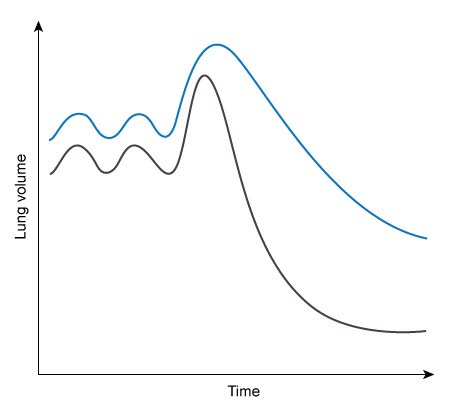 Which of the following measures is increased in this patient?
Which of the following measures is increased in this patient?
A)Expiratory reserve volume
B)Forced expiratory volume in 1 second
C)Forced expiratory volume in 1 second/forced vital capacity ratio
D)Forced vital capacity
E)Residual volume/total lung capacity ratio
 Which of the following measures is increased in this patient?
Which of the following measures is increased in this patient?A)Expiratory reserve volume
B)Forced expiratory volume in 1 second
C)Forced expiratory volume in 1 second/forced vital capacity ratio
D)Forced vital capacity
E)Residual volume/total lung capacity ratio

Unlock Deck
Unlock for access to all 339 flashcards in this deck.
Unlock Deck
k this deck
49
A 70-year-old woman has participated in a long-term aging study for the past 30 years. Her medical history is significant for osteoporosis, and the steady loss of vertebral body height has led to a mild case of kyphosis. She has no extra medical conditions and is otherwise healthy and active. She doesn't smoke. Which of the following modifications to her physiology test from years ago is more compatible with natural aging? 
A)A
B)B
C)C
D)D
E)E
F)F

A)A
B)B
C)C
D)D
E)E
F)F

Unlock Deck
Unlock for access to all 339 flashcards in this deck.
Unlock Deck
k this deck
50
An elderly guy in his 80s has been taking part in a longitudinal study of aging. He doesn't have any serious medical issues. In order to track long-term changes in pulmonary gas exchange, arterial blood gas samples are taken once every ten years on room air at sea level. Which of the following outcomes is most consistent with normal aging as compared to 30 years ago? 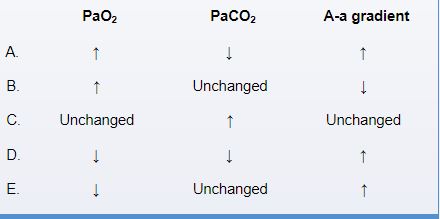
A)A
B)B
C)C
D)D
E)E

A)A
B)B
C)C
D)D
E)E

Unlock Deck
Unlock for access to all 339 flashcards in this deck.
Unlock Deck
k this deck
51
An upper respiratory tract illness led to the 81-year-old man's visit to the office. Except for a faint, ineffective cough that is especially annoying at night, his symptoms have mostly subsided. Osteoarthritis of the knee and hypertension are medical histories. The patient still plays golf on the weekends and is physically active. He has no known environmental exposures and is a retired insurance executive. He had never smoked before. The chest x-ray is normal, and the physical examination is uneventful. In this patient, pulmonary function testing is under consideration. Which of the following alterations is most likely anticipated in this patient as a result of normal aging in comparison to midlife? 
A)A
B)B
C)C
D)D
E)E

A)A
B)B
C)C
D)D
E)E

Unlock Deck
Unlock for access to all 339 flashcards in this deck.
Unlock Deck
k this deck
52
A woman, 44, visits the office for follow-up. The patient fell from a cliff while hiking and had a total C7 spinal cord damage. She uses a wheelchair and can move her shoulders and upper arms, but she is paralyzed. Due to a neurogenic bladder, the patient has a suprapubic catheter. She doesn't have any other illnesses. She has never smoked in her life. Which of the following respiratory parameter changes in this patient is most likely true? 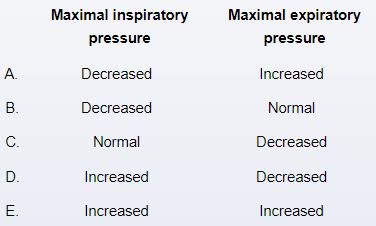
A)A
B)B
C)C
D)D
E)E

A)A
B)B
C)C
D)D
E)E

Unlock Deck
Unlock for access to all 339 flashcards in this deck.
Unlock Deck
k this deck
53
Researchers are looking into how stimulation with neurotransmitters affects the membrane potential of postsynaptic neurons. Baseline experiments show that high membrane permeability for a certain ion generates the resting membrane potential. In response to the onset of neurotransmitter stimulation, ligand-gated ion channels open (black arrow) and enhance the membrane's permeability for an alternative ion, altering the membrane potential. This causes voltage-gated ion channels (red arrow) to open slowly, increasing the permeability of the membrane for a third kind of ion. The graph below displays the experiment's findings.  The equilibrium potentials of different ions under physiologic conditions are as follows:
The equilibrium potentials of different ions under physiologic conditions are as follows:  Which of the following options would best explain the changes in this neuron's membrane potential during the experiment?
Which of the following options would best explain the changes in this neuron's membrane potential during the experiment?

A)A
B)B
C)C
D)D
E)E
 The equilibrium potentials of different ions under physiologic conditions are as follows:
The equilibrium potentials of different ions under physiologic conditions are as follows:  Which of the following options would best explain the changes in this neuron's membrane potential during the experiment?
Which of the following options would best explain the changes in this neuron's membrane potential during the experiment?
A)A
B)B
C)C
D)D
E)E

Unlock Deck
Unlock for access to all 339 flashcards in this deck.
Unlock Deck
k this deck
54
Recordings of a giant squid axon's membrane potential are being examined by neurophysiologists. On the slide below, a selection from their recordings is displayed.  The membrane is most permeable to potassium ions at which of the following points?
The membrane is most permeable to potassium ions at which of the following points?
A)A
B)B
C)C
D)D
E)E
 The membrane is most permeable to potassium ions at which of the following points?
The membrane is most permeable to potassium ions at which of the following points?A)A
B)B
C)C
D)D
E)E

Unlock Deck
Unlock for access to all 339 flashcards in this deck.
Unlock Deck
k this deck
55
According to research, synaptic transmission is potentiated as a result of repeated stimulation of hippocampus neurons involved in memory and learning. Below are patch-clamp recordings of activated neurons. (dotted line: baseline; solid line: after repeated stimulation [potentiated]). ![<strong>According to research, synaptic transmission is potentiated as a result of repeated stimulation of hippocampus neurons involved in memory and learning. Below are patch-clamp recordings of activated neurons. (dotted line: baseline; solid line: after repeated stimulation [potentiated]). Which of the following neurotransmitter receptors on the postsynaptic membrane is most likely involved in this process?</strong> A)Dopamine D<sub>2</sub> receptor B)GABA-B receptor C)Glutamate NMDA receptor D)Glycine receptor E)Norepinephrine alpha-2 receptor](https://d2lvgg3v3hfg70.cloudfront.net/MD0001/11ec160b_3cd2_28a2_9249_4b8cf7ff1e51_MD0001_00.jpg) Which of the following neurotransmitter receptors on the postsynaptic membrane is most likely involved in this process?
Which of the following neurotransmitter receptors on the postsynaptic membrane is most likely involved in this process?
A)Dopamine D2 receptor
B)GABA-B receptor
C)Glutamate NMDA receptor
D)Glycine receptor
E)Norepinephrine alpha-2 receptor
![<strong>According to research, synaptic transmission is potentiated as a result of repeated stimulation of hippocampus neurons involved in memory and learning. Below are patch-clamp recordings of activated neurons. (dotted line: baseline; solid line: after repeated stimulation [potentiated]). Which of the following neurotransmitter receptors on the postsynaptic membrane is most likely involved in this process?</strong> A)Dopamine D<sub>2</sub> receptor B)GABA-B receptor C)Glutamate NMDA receptor D)Glycine receptor E)Norepinephrine alpha-2 receptor](https://d2lvgg3v3hfg70.cloudfront.net/MD0001/11ec160b_3cd2_28a2_9249_4b8cf7ff1e51_MD0001_00.jpg) Which of the following neurotransmitter receptors on the postsynaptic membrane is most likely involved in this process?
Which of the following neurotransmitter receptors on the postsynaptic membrane is most likely involved in this process?A)Dopamine D2 receptor
B)GABA-B receptor
C)Glutamate NMDA receptor
D)Glycine receptor
E)Norepinephrine alpha-2 receptor

Unlock Deck
Unlock for access to all 339 flashcards in this deck.
Unlock Deck
k this deck
56
To identify the variables influencing vascular resistance, a researcher is performing an experiment. Animals used in experiments are sedated, intubated, and connected to a ventilator under control. Each animal has a catheter inserted into a tiny artery in a different organ. The catheter is attached to an oximeter and a manometer, which both record oxygen saturation and pressure over time. At regular intervals, arteriolar resistance is determined from the manometer data and the fraction of inspired oxygen is gradually altered. The results shown below were most likely obtained from which of the following organs? 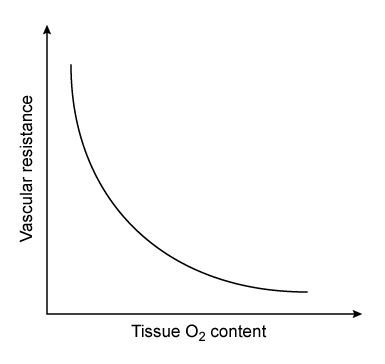
A)Brain
B)Heart
C)Kidneys
D)Lungs
E)Small intestine

A)Brain
B)Heart
C)Kidneys
D)Lungs
E)Small intestine

Unlock Deck
Unlock for access to all 339 flashcards in this deck.
Unlock Deck
k this deck
57
A boy's micropenis was discovered when he was a newborn. The Sertoli cell activity is selectively impaired as a result of a known mutation in the NR5A1/SF-1 gene, according to genetic study. Unaffected is the rest of the hypothalamic-pituitary-gonadal axis. The patient has a generally normal childhood and pubertal development and receives routine follow-up care from a pediatric endocrinologist. His serum hormone levels are measured at age 16. Which of the following blood hormone pattern patterns is most indicative of this patient's condition? 
A)A
B)B
C)C
D)D
E)E

A)A
B)B
C)C
D)D
E)E

Unlock Deck
Unlock for access to all 339 flashcards in this deck.
Unlock Deck
k this deck
58
A 35-year-old man who passed out in his garage is taken to the emergency room. He recently acquired a vintage 1960s convertible, which he was restoring when he passed out. The garage door was partially open when the patient was inside. After two hours of working on the automobile with the engine running, he passed out. The patient does not use any drugs and has no known medical conditions. He doesn't consume any alcohol, tobacco, or illegal substances. What combination of results from an arterial blood sample collected when the patient lost consciousness best reflects the rest of the options? 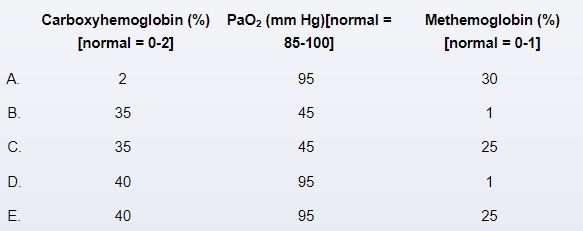
A)A
B)B
C)C
D)D
E)E

A)A
B)B
C)C
D)D
E)E

Unlock Deck
Unlock for access to all 339 flashcards in this deck.
Unlock Deck
k this deck
59
A physiologist is conducting an experiment to study humen blood circulation. He assess the oxygen consumption in various organs in a healthy man. During the study, the blood oxygen content of the aorta and several other vessels is measured at rest. The greatest difference in these measurements will most likely be between the aorta and which of the following blood vessels?
A)Brachial vein
B)Coronary sinus
C)Internal jugular vein
D)Portal vein
E)Pulmonary artery
F)Renal vein
A)Brachial vein
B)Coronary sinus
C)Internal jugular vein
D)Portal vein
E)Pulmonary artery
F)Renal vein

Unlock Deck
Unlock for access to all 339 flashcards in this deck.
Unlock Deck
k this deck
60
In an animal experiment, the pancreatic duct is cannulated and the gland is subjected to various secretory stimulation. When the constituents of pancreatic fluid are measured, the following tracings are produced: 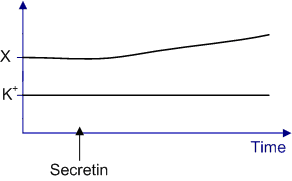 Substance 'X' is most likely which of the following?
Substance 'X' is most likely which of the following?
A)Sodium
B)Chloride
C)Trypsinogen
D)Bicarbonate
E)Phosphate
 Substance 'X' is most likely which of the following?
Substance 'X' is most likely which of the following?A)Sodium
B)Chloride
C)Trypsinogen
D)Bicarbonate
E)Phosphate

Unlock Deck
Unlock for access to all 339 flashcards in this deck.
Unlock Deck
k this deck
61
A 40-year-old man is being evaluated in the office for routine health follow up. He states that he feels chest discomfort which started 2 days ago. He is well and active , he also has a family history of an ischemic heart disease. The patient has no medical conditions and does not use tobacco. He leads an active lifestyle and exercises every day. He undergoes treadmill exercise stress testing. Baseline blood pressure is 120/73 mm Hg and pulse is 59/min. After 10 minutes of exercise, his blood pressure is 156/82 mm Hg and pulse is 153/min. He has no chest pain and ECG shows no abnormalities. Compared to pretest conditions, which of the following is the single most important limiting factor for left ventricular myocardial blood supply during the test?
A)Contraction force
B)Coronary vasoconstriction
C)Diastolic aortic pressure
D)Duration of diastole
E)Intraventricular pressure
F)Systolic ventricular wall stress
A)Contraction force
B)Coronary vasoconstriction
C)Diastolic aortic pressure
D)Duration of diastole
E)Intraventricular pressure
F)Systolic ventricular wall stress

Unlock Deck
Unlock for access to all 339 flashcards in this deck.
Unlock Deck
k this deck
62
In the clinic, a 50-year-old man with a tenuous history of alcoholism is examined for recurrent diarrhea and weight loss. For the past two years, the patient has experienced everyday loose stools and bloating. His feces are described as oily and foul-smelling. Despite normal abdominal imaging, pancreatic insufficiency is suspected. As hormone A is administered intravenously, the patient is put through a test in which the bicarbonate content in duodenal aspirates is assessed. The graph below shows the data plotted.  Hormone A is most likely produced by which of the following cell types?
Hormone A is most likely produced by which of the following cell types?
A)Duodenal S cells
B)Gastric G cells
C)Pancreatic alpha cells
D)Pancreatic beta cells
E)Parenchymal hepatocytes
F)Renal peritubular cells
 Hormone A is most likely produced by which of the following cell types?
Hormone A is most likely produced by which of the following cell types?A)Duodenal S cells
B)Gastric G cells
C)Pancreatic alpha cells
D)Pancreatic beta cells
E)Parenchymal hepatocytes
F)Renal peritubular cells

Unlock Deck
Unlock for access to all 339 flashcards in this deck.
Unlock Deck
k this deck
63
A 62-year-old guy visits the office to have his abdominal swelling examined. His abdomen has gotten increasingly bloated over the past few weeks, and this has been accompanied by some slight discomfort and a loss of appetite. There have been some admissions for alcohol-induced pancreatitis in the past. The patient currently consumes one pint of alcohol every day and abstains from using tobacco or other substances. Physical examination reveals many spider angiomas on the upper chest and a moderately icteric sclera. When the patient lies on either side, the dullness to percussion shifts to a different position due to the enlarged abdomen. Creatinine is 1.1 mg/dL and serum sodium is 130 mEq/dL. Which of the following would this patient most likely exhibit? 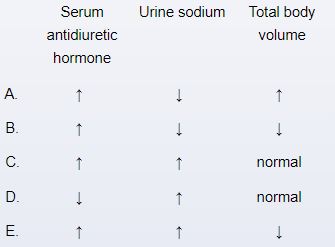
A)A
B)B
C)C
D)D
E)E

A)A
B)B
C)C
D)D
E)E

Unlock Deck
Unlock for access to all 339 flashcards in this deck.
Unlock Deck
k this deck
64
A 62-year-old guy visits the office to have his abdominal swelling examined. His abdomen has gotten increasingly bloated over the past few weeks, and this has been accompanied by some slight discomfort and a loss of appetite. There have been some admissions for alcohol-induced pancreatitis in the past. The patient currently consumes one pint of alcohol every day and abstains from using tobacco or other substances. Physical examination reveals many spider angiomas on the upper chest and a moderately icteric sclera. When the patient lies on either side, the dullness to percussion shifts to a different position due to the enlarged abdomen. Creatinine is 1.1 mg/dL and serum sodium is 130 mEq/dL. Which of the following would this patient most likely exhibit? 
A)A
B)B
C)C
D)D
E)E

A)A
B)B
C)C
D)D
E)E

Unlock Deck
Unlock for access to all 339 flashcards in this deck.
Unlock Deck
k this deck
65
A 42-year-old man with swollen legs shows up at the office. Along with a 7 kg (15.4 lb) weight gain, he has also had progressive abdominal distension and eye yellowing during the past three weeks. The patient has previously been taken to the hospital for intoxication and seizures and consumes at least 8 beers every day. He denies using drugs intravenously or smoking. Vital indicators are in the expected range. There are palmar erythema, spider angiomas, and scleral icterus. A normal heartbeat and rhythm can be heard during cardiac auscultation, and there is no jugular venous distension. Breathing noises are typical. A fluid wave can be easily triggered due to the abdomen's widespread enlargement. There is bilateral lower extremity pinning edema. Which of the following pathophysiologic changes is most likely present in this patient? 
A)A
B)B
C)C
D)D
E)E

A)A
B)B
C)C
D)D
E)E

Unlock Deck
Unlock for access to all 339 flashcards in this deck.
Unlock Deck
k this deck
66
A researcher is working to develop a new medication fot treatment fo patient with heart failure. if this treatment improve patient symptoms by increasing urine output and decreasing peripheral vascular resistance. The medication works by inhibiting a metalloprotease to prolong the action of endogenous polypeptides. These polypeptides are most likely secreted by which of the following cell types?
A)Adrenal zona glomerulosa cells
B)Cardiomyocytes
C)Hepatic stellate cells
D)Myocardial Purkinje fibers
E)Renal juxtaglomerular cells
F)Vascular endothelial cells
A)Adrenal zona glomerulosa cells
B)Cardiomyocytes
C)Hepatic stellate cells
D)Myocardial Purkinje fibers
E)Renal juxtaglomerular cells
F)Vascular endothelial cells

Unlock Deck
Unlock for access to all 339 flashcards in this deck.
Unlock Deck
k this deck
67
A woman in her 26s visits the doctor for follow-up regarding erratic menstruation cycles (paragraph 0). Every 15-90 days, she has a period, which lasts 2-14 days and can include anything from spotting to quarter-sized clots. The patient and her husband have been trying to get pregnant, but because of the patient's irregular menstrual cycles, it has been challenging to time sexual activity. She has been working out and reducing weight; as a result, her BMI has decreased to 32 kg/m2. A normal adnexa, tiny, mobile uterus, and external genitalia are seen upon gynecologic examination. A sample of the endometrium displays coiled glands producing mucus rich in carbohydrates, an edematous stroma, and twisted spiral arteries. Where on the following graph was the endometrial sample most likely taken? 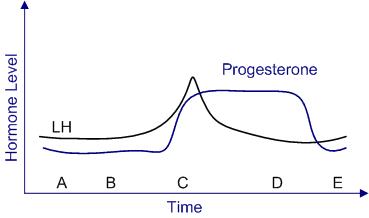
A)A
B)B
C)C
D)D
E)E

A)A
B)B
C)C
D)D
E)E

Unlock Deck
Unlock for access to all 339 flashcards in this deck.
Unlock Deck
k this deck
68
A 65-year-old amn is brought to the emergency department after he passed away 30 minutes ago. He was shaving his bear and felt a lightheadedness while shaving around his neck. He has a same episode befor when a physician in ER tried to put a neck collar, blood pressure was 70/40 mm Hg and pulse was 45/min during that episode. Past medical history is significant for hypertension and diet-controlled diabetes mellitus. The patient is a lifetime nonsmoker and drinks alcohol on social occasions. On physical examination, his blood pressure is 125/72 mm Hg and pulse is 76/min without orthostatic changes. Stimulation of afferent sensory fibers in which of the following nerves is most likely responsible for this patient's symptoms?
A)Accessory
B)Glossopharyngeal
C)Hypoglossal
D)Trigeminal
E)Vagus
A)Accessory
B)Glossopharyngeal
C)Hypoglossal
D)Trigeminal
E)Vagus

Unlock Deck
Unlock for access to all 339 flashcards in this deck.
Unlock Deck
k this deck
69
A 24-year-old healthy lady participates in a research study on exercise. The source of skeletal muscle ATP during exercise is determined in the study using a variety of radiolabeled substances. The participants are given food that is heavy in carbohydrates and instructed to run quickly on a treadmill. Which of the following is the most likely source of the red curve on the graph below, which represents ATP? 
A)Amino acids
B)Free fatty acids
C)Glycogen
D)Ketone bodies
E)Phosphocreatine

A)Amino acids
B)Free fatty acids
C)Glycogen
D)Ketone bodies
E)Phosphocreatine

Unlock Deck
Unlock for access to all 339 flashcards in this deck.
Unlock Deck
k this deck
70
A 60-year-old man is brought to the ER due to shortenss of breath after an exertional exercise. He has no associated cough or wheezing. he has a history of hypertension and diabetes mellitus and takes his medication regularly. His father died due to myocardial infarction. ECG, chest x-ray, exercise stress test, and echocardiogram are obtained to evaluate his symptoms. He subsequently undergoes right and left cardiac catheterization, and the results are as follows: Arteial blood oxygen content 20 mL O2/ 100 mL blood
Pulmonary artery diastolic pressure 12 mmHg
Left ventricular diastolic pressure 10 mmHg
Mean right arterial pressure 4 mmHg
Venous blood oxygen content 15 mL O2/ 100 mL blood
What additional information is necessary to calculate cardiac output in this patient?
A)Arteriovenous difference in oxygen content
B)Oxygen-binding capacity of hemoglobin
C)Percentage of hemoglobin saturation
D)Rate of oxygen consumption
E)Respiratory quotient
Pulmonary artery diastolic pressure 12 mmHg
Left ventricular diastolic pressure 10 mmHg
Mean right arterial pressure 4 mmHg
Venous blood oxygen content 15 mL O2/ 100 mL blood
What additional information is necessary to calculate cardiac output in this patient?
A)Arteriovenous difference in oxygen content
B)Oxygen-binding capacity of hemoglobin
C)Percentage of hemoglobin saturation
D)Rate of oxygen consumption
E)Respiratory quotient

Unlock Deck
Unlock for access to all 339 flashcards in this deck.
Unlock Deck
k this deck
71
Fifty obese adults without diabetes mellitus are enrolled in a 10-week weight loss program. The program includes a low-calorie diet and moderate-intensity exercise for at least 150 minutes per week. The study subjects who are adherent to the regimen lose an average of 7 kg (15.5 lb) at the end of 10 weeks. Venous blood samples to study biochemical changes induced by weight loss are taken at the start of the trial and at the 10-week follow-up visit. Which of the following hormonal changes are likely to occur during the course of the study? 
A)A
B)B
C)C
D)D
E)E

A)A
B)B
C)C
D)D
E)E

Unlock Deck
Unlock for access to all 339 flashcards in this deck.
Unlock Deck
k this deck
72
A physiologist is trying to study the cardiac action potential. He takes the reading from 4 different points within normal cardiac tissue. The results, expressed in terms of speed of conduction (meters per second), are as follows:Point 1 - 0.05 m/sec Point 2 - 0.3 m/sec
Point 3 - 1.1 m/sec
Point 4 - 2.2 m/secFrom the following list of locations, which most likely corresponds to the order of points 1-2-3-4 (AV = atrioventricular)?
A)Atrial muscle, ventricular muscle, Purkinje system, AV node
B)AV node, Purkinje system, ventricular muscle, atrial muscle
C)AV node, ventricular muscle, atrial muscle, Purkinje system
D)Purkinje system, AV node, ventricular muscle, atrial muscle
E)Ventricular muscle, AV node, Purkinje system, atrial muscle
Point 3 - 1.1 m/sec
Point 4 - 2.2 m/secFrom the following list of locations, which most likely corresponds to the order of points 1-2-3-4 (AV = atrioventricular)?
A)Atrial muscle, ventricular muscle, Purkinje system, AV node
B)AV node, Purkinje system, ventricular muscle, atrial muscle
C)AV node, ventricular muscle, atrial muscle, Purkinje system
D)Purkinje system, AV node, ventricular muscle, atrial muscle
E)Ventricular muscle, AV node, Purkinje system, atrial muscle

Unlock Deck
Unlock for access to all 339 flashcards in this deck.
Unlock Deck
k this deck
73
A 26-year-old male presents to the emergency room complaining of right-sided scrotal soreness that has been becoming worse over the past 10 hours. The patient has a unilateral orchiectomy after clinical and radiological examinations reveal testicular torsion with substantial ischemia damage. He returns to the office for follow-up three months later. The patient is otherwise in good condition and does not take any drugs, but she is concerned about the possibility of infertility and sexual dysfunction. Which of the following sets of results in this case are most likely to be revealed by further testing? 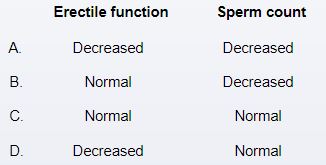
A)A
B)B
C)C
D)D

A)A
B)B
C)C
D)D

Unlock Deck
Unlock for access to all 339 flashcards in this deck.
Unlock Deck
k this deck
74
The patient's genetic defect has resulted in decreased beta globin chain synthesis. Which of the following is most likely to be seen on laboratory testing?
A)Hyperchromia
B)Iron deficiency
C)Microcytosis
D)Red blood cell sickling
E)Spherocytosis
A)Hyperchromia
B)Iron deficiency
C)Microcytosis
D)Red blood cell sickling
E)Spherocytosis

Unlock Deck
Unlock for access to all 339 flashcards in this deck.
Unlock Deck
k this deck
75
An examination of the boy's irritation, sluggish development, and acne is the reason a 16-year-old is brought into the office. The patient participates in soccer and has been pursuing a rigorous strength-training regimen. He acknowledges using a performance-enhancing drug for the previous six months when questioned. What new discoveries are most likely to have been made in this patient since six months ago? 
A)A
B)B
C)C
D)D
E)E
F)F

A)A
B)B
C)C
D)D
E)E
F)F

Unlock Deck
Unlock for access to all 339 flashcards in this deck.
Unlock Deck
k this deck
76
A 43-year-old lady arrives to the office feeling more and more worn out and gaining weight while eating less. I haven't been feeling like myself lately, she says. The patient requests to be sent to a dermatologist since her formerly "lovely" skin has started to dry up. She believes that a dermatologist can also assist with her hair loss issue. High serum TSH, low triiodothyronine (T3), and low thyroxine (T4) levels are found by laboratory analysis. The patient requests to take this drug since a member of her family who suffers from fatigue found that their energy level improved after using liothyronine (T3) supplements. Which of the following changes in the patient's hormone levels would be most probable as a result of this therapy's administration? 
A)A
B)B
C)C
D)D
E)E

A)A
B)B
C)C
D)D
E)E

Unlock Deck
Unlock for access to all 339 flashcards in this deck.
Unlock Deck
k this deck
77
A 30-year-old woman arrives at the clinic complaining of substantial weight gain despite not making any dietary or exercise adjustments. Additionally, she has been experiencing regular constipation and a recent increase in fatigue. The patient is drug-free and has no history of illness. She had a healthy baby three years ago after having one pregnancy. Family history is significant for her mother's thyroid condition. Both the blood pressure and the pulse measure 116/90 mm Hg. 28.5 kg/m2 is the BMI. Upon physical examination, the thyroid is found to be diffusely enlarged, non-tender, and free of nodules. Deep tendon reflexes take longer to relax. Her skin seems dry, and she has scant hair. Which of the following sets of laboratory findings is most likely to be seen in this patient? 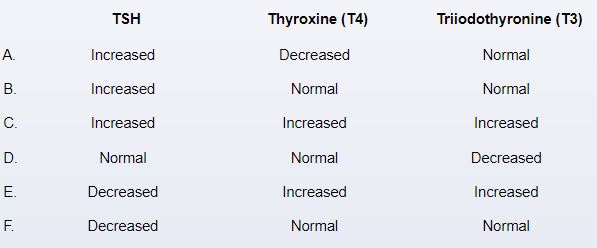
A)A
B)B
C)C
D)D
E)E
F)F

A)A
B)B
C)C
D)D
E)E
F)F

Unlock Deck
Unlock for access to all 339 flashcards in this deck.
Unlock Deck
k this deck
78
After a similar amount of oral and intravenous glucose has been administered, researchers evaluate the blood insulin levels of healthy volunteers. We see the following curves:  Which of the following endogenous substances best explains the difference between the curves?
Which of the following endogenous substances best explains the difference between the curves?
A)Insulin-like growth factor-1
B)Glucagon-like peptide-1
C)Somatostatin
D)Secretin
E)Cholecystokinin
 Which of the following endogenous substances best explains the difference between the curves?
Which of the following endogenous substances best explains the difference between the curves?A)Insulin-like growth factor-1
B)Glucagon-like peptide-1
C)Somatostatin
D)Secretin
E)Cholecystokinin

Unlock Deck
Unlock for access to all 339 flashcards in this deck.
Unlock Deck
k this deck
79
A 35-year-old woman is being evaluated due to recent exertional dyspnea and fatigue. She has no prior medical condition and has a sedentary lifestyle. She feels a retrosternal pain accompined with shortenss of breath during exercise. An EKG shows no significant findings. A heart cathetrization is planned. During the procedure, the catheter records periodic pressure changes with a maximum of 25 mm Hg and minimum of 2 mm Hg. The catheter is advanced further, and then shows periodic pressure changes with a maximum of 25 mm Hg and a minimum of 10 mm Hg. Assuming the results of the procedure are normal, the first set of readings was most likely obtained from which of the following locations?
A)Left atrium
B)Left ventricle
C)Pulmonary artery
D)Right atrium
E)Right ventricle
A)Left atrium
B)Left ventricle
C)Pulmonary artery
D)Right atrium
E)Right ventricle

Unlock Deck
Unlock for access to all 339 flashcards in this deck.
Unlock Deck
k this deck
80
A 50 year-old male is being evaluated due to exertional dyspnea. He is a known case of chronic kidney failure which receives hemodialysis 3 times weekly. Chest x-ray reveals cardiomegaly and pulmonary congestion. Further evaluation determines that hir symptoms are likely due to persistence of the arteriovenous fistula that is used for hemodialysis. Which of the following physiologic changes are most likely present in this patient due to the fistula? 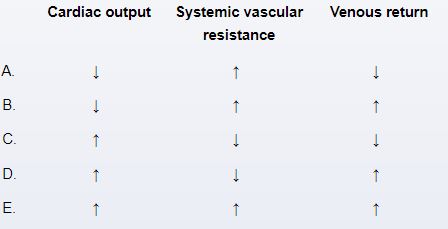
A)A
B)B
C)C
D)D
E)E

A)A
B)B
C)C
D)D
E)E

Unlock Deck
Unlock for access to all 339 flashcards in this deck.
Unlock Deck
k this deck



